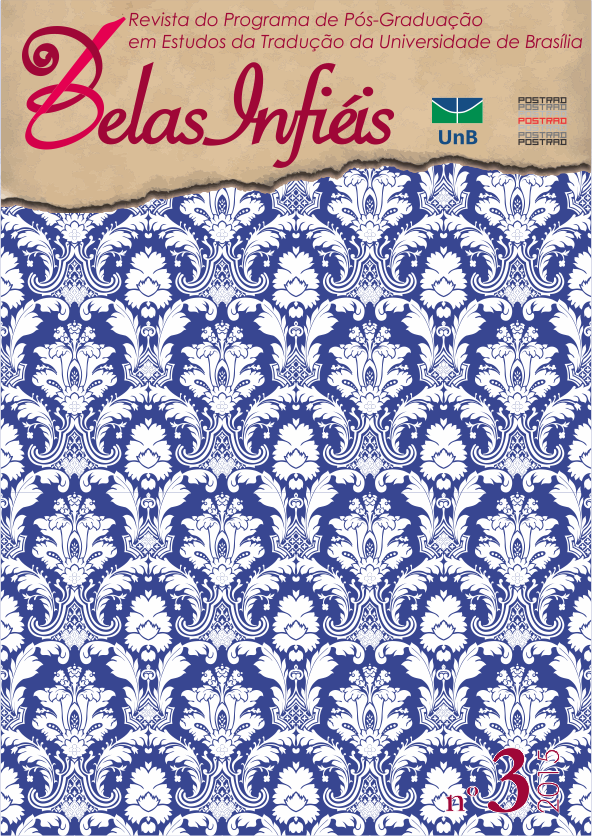O QUE É IMPORTANTE PARA UMA INTERPRETAÇÃO SIMULTÂNEA EM LÍNGUA DE SINAIS NO CONTEXTO ARTÍSTICO?
DOI:
https://doi.org/10.26512/belasinfieis.v4.n3.2015.11348Palabras clave:
Interpretação simultânea artística, Literatura surda, Performance em língua de sinaisResumen
Esse artigo avalia quais elementos um público não fluente em língua de sinais considera prescindíveis para interpretação simultânea (IS) de uma narrativa em língua de sinais. Os contos em língua de sinais são performances visuais que constituem uma rede complexa de informações linguísticas e semióticas, gestos e expressões corporais. Analisamos, neste trabalho, as percepções de alunos do curso técnico de tradução e interpretação do IFSC ”“ Campus Palhoça Bilíngue sobre dois tipos de interpretação simultânea (a primeira com muitas informações linguísticas, a segunda com poucas informações linguísticas) de um conto tecido em LIBRAS, intitulado “Sinais no metrô”. O tradutor-intérprete é um mediador cultural e tem em sua tarefa múltiplos desafios, entre eles o de construir no texto oral os aspectos visuais inerentes à língua de sinais. A pesquisa pretende oferecer uma amostra de como um público não fluente em língua de sinais, mas em processo formativo de tradução e interpretação, pode se relacionar com a performance artística e a interpretação simultânea. A investigação mostrou que a maioria dos alunos se sentem mais seguros com IS completa (com mais informações linguísticas). Entretanto, reconheceram que informações semióticas não precisariam ser interpretadas de forma a descrever a sinalização, dessa forma, promovendo o que pretendemos chamar de interpretação simultânea artística (ISA) que seria preservar o contato do espectador com os elementos visuais do texto
Descargas
Citas
ARAUJO, F. M. de. Simetria na Poética Visual na Língua de Sinais Brasileira. Florianópolis: Dissertação [Mestrado em Estudos da Tradução] -UFSC. 2013.
BAHAN, Benjamin. Face-to-face Tradition in the American Deaf Community.Dynamics of the Teller, the Tale and the Audience. In: H-Dirksen L. Bauman, Jennifer L. Nelson, and Heidi M. Rose. Signing the Body Poetic: Essays on American Sign Language Literature. UNIVERSIDADE OF CALIFORINIA PRESS, 2006.
FELICIO, M. D. O Surdo e a contação de histórias: análise da interpretação simultânea do conto “Sinais no metrô”. Florianópolis: Dissertação [Mestrado em Estudos da Tradução] ”“UFSC. 2013.
GILE, D. The Effort Models in Interpretation. In: _____. Basic Concepts and Models for Interpreter and Translator Training. Amsterdam/Philadelphia: John Benjamins, 1995. p. 159-190.
KRENTZ, Christopher ‘The camera as printing press; How film has influenced ASL literature’ in H-Dirksen Bauman, Jennifer Nelson & Heidi Rose (eds.) Signing the Body Poetic(California: University of California Press), 2006.
NAPIER, J.; MCKEE, R.; GOSWELL, D. Sign Language Interpreting: theory & practice in Australia and New Zealand. Sydney: The Federation Press, 2006.
PAGURA, Reynaldo. A interpretação de conferências: interfaces com a tradução escrita e implicações para formação de intérpretes e tradutores. DELTA, São Paulo, V.19. spe, p. 209-236, 2003.
PAVIS, P. Dicionário de teatro. [tradução: J. Guinsburg e Maria Lúcia Pereira] 3ª ed. São Paulo: Perspectiva, 2008.
QUADROS, Ronice M. de; SUTTON-SPENCE, Rachel. Poesia em sinais: traços da identidade surda. In: QUADROS, R. M. de (Org.). Estudos surdos I: série de pesquisas. Petrópolis: Arara Azul, 2006.
_____. O tradutor e intérprete de língua brasileira de sinais e língua portuguesa. Brasília: Secretaria de Educação Especial; MEC, 2007.
SUTTON-SPENCE, Rachel; QUADROS, Ronice M. Performance poética em sinais: o que a audiência precisa para entender a poesia em sinais. Estudos em Língua de Sinais. v. 2. Florianópolis: Editora Insular. 2013.
WILCOX, S. Aprender a ver. Rio de Janeiro: Arara Azul, 2005.
WURM, Svenja (2010) ‘Translation across modalities: The practice of translating written text into recorded signed language’. Unpublished Doctoral dissertation, Heriot-WattUniversity, Department of Languages and Intercultural Studies.
Descargas
Publicado
Cómo citar
Número
Sección
Licencia
Copyright Statement
Given the public access to this journal, the texts are free to use but requires the recognition of the original authorship and initial publication in this journal to be properly stated.
The journal allows the use of works published for non-commercial purposes, including the right to submit the work to publicly accessible databases. Published contributions are the sole and exclusive responsibility of the author(s).
- When submitting papers to be evaluated by the Belas Infiéis journal, the author(s):
- Declare that the contents of the contributions are original and of their original creation, being entirely responsible for their content if there is an objection by third parties.
- Claim to be aware that they should not commit academic plagiarism.
- Declare that the manuscript has not been published, completely or partially, in Portuguese or another language. If it is a translation it should be submitted to the Translated Articles section.
- Declare that the manuscript is not being evaluated by other journals.
- Declare that the manuscript was not submitted to another journal simultaneously.
- Commit(s) to inform the journal of any kind of error or inaccuracy in their contribution (published, in evaluation or in editing) and to collaborate with the editors to make due corrections of the article (when in evaluation or editing) or erratum/retraction (after publication).
- Declare that there is no conflict of interest regarding the published work.
- Authorize its release if it is accepted for publication without any kind of monetary compensation.
- Agree to assign non-exclusive rights to publication to the magazine, remaining free to make their contribution available in other media as long as the publication of the first version in Belas Infiéis magazine is mentioned. They also authorize Belas Infiéis to assign their texts for reproduction in content indexers, virtual libraries and similar platforms.
- Maintain copyright and grant the journal the right of first publication, the work being licensed under theCreative Commons Attribution License.
- Is/Are allowed and encouraged to publish and distribute their work online after the editorial process, which may increase the impact and citation of the published work.
- Authorize the editorial team to make textual adjustments and to adapt the article to the publication rules, when necessary.



















